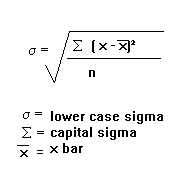A measure of the variability in scores i.e. the ‘scatter’ or ‘spread’ of the separate scores around their central tendency. In fact central tendencies are central values around which the individual observations are distributed. They give us an idea of location of the distribution, but tell us nothing as to how the individual item are scattered.
The following are main measures of variability or dispersion of the individual observation in the population:
It is the difference between the highest and the lowest scores. It is the most general measure of the ‘spread’ of ‘scatter’ of the series and is used only to make a rough comparison of two or more groups of variability. The range takes account of the extremes of the series of score only, and is unreliable when N is small or when there are large gaps in the frequency distributions.
The quartile deviation or Q is one-half the scale distance between the 75th & 25th percentile in a frequency distribution. The 25th percentile or Q1 is the first quartile on the score scale, the point below which lies 25% of the scores or Q3 is the third quartile on the score scale the point below which lies 75% of the scores. When we have these two points the quartile deviation or Q is found from the formula.
Q = (Q3 – Q1) / 2The average deviation or A.D. is the mean of the deviations of all the separate scores in a series taken from their mean (occasionally from the median or mode). In averaging deviations to find A.D., no account is taken of signs, and all the deviations plus or minus are treated as positive.
A.D. = Σ|x - μ| / NThe standard Deviation is the most widely used measure of dispersion. It is a positive square root of the mean of the squares of the deviations from the arithmetic mean and it is denoted by a Greek letter σ (sigma) and in short it is called S.D.

The term variance was used to describe the square of the standard deviation. The variance is defined as: Variance is the average squared deviations from the arithmetic mean and standard deviation is the square root of the variance. The smaller the value σ2 the lesser the variability or greater the uniformity in the population.
When we wish to compare two groups on one trait or one group on two traits comparison of means and standard deviation may lead to erroneous results. In order to find some manner this is independent of the absolute size of the variables. That can be done by calculating the coefficient of variation (V) in each case.
V = 100 X S.D / Mean
SUBMIT ASSIGNMENT NOW!Sign up for free and get instant discount of 12% on your first order
Coupon: SHD12FIRST